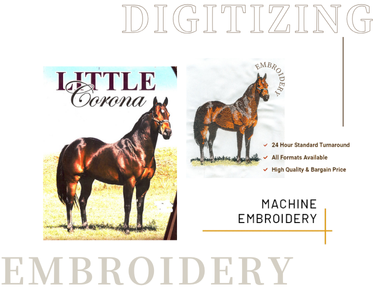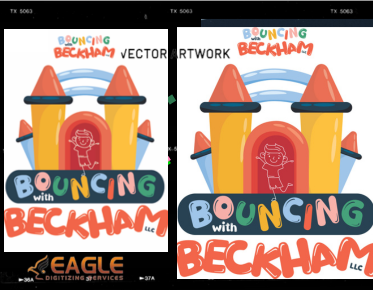How to Calculate Stitch Counts on Digitized Embroidery Easily
Embroidery is more than just a craft; it’s a delicate balance of design, precision, and efficiency. One of the most essential components in achieving the perfect embroidered piece is stitch count. Stitch count refers to the total number of individual stitches that make up an embroidery design. Understanding and mastering stitch counts is key for designers, manufacturers, and anyone involved in the embroidery process. Why? Because it determines everything from the overall appearance to the cost-effectiveness and longevity of the final product.
Why
Stitch Count Matters for Quality Embroidery
The number of stitches in a design directly influences its quality.
Too few stitches, and the image or text might appear sparse or lack detail. Too
many, and you risk a bulky, overly dense design that can make the fabric stiff
and heavy. The right stitch count ensures your embroidery looks vibrant, crisp,
and well-formed. A precise stitch count also contributes to the longevity of
the design, as overloading an area with stitches can lead to wear and tear
faster than an evenly balanced design. Achieving this balance ensures that your
embroidery not only looks professional but stands the test of time.
How
Stitch Count Impacts Pricing and Production Time
Stitch count isn’t just a matter of aesthetics—it’s a key factor in
determining the cost of an embroidery job. More stitches mean more time on the
machine, and ultimately, more thread consumed. Because of this, high stitch
count designs are often priced higher due to the labor and resources required.
For large production orders, stitch count can drastically affect both time and
cost efficiency. Accurate estimation of stitch count helps businesses avoid
unexpected expenses and streamline production timelines, ensuring projects are
completed within budget and on time.
The
Connection Between Stitch Count and Thread Consumption
Thread consumption is directly tied to stitch count. Each stitch uses
up a certain amount of thread, so a higher stitch count means more thread will
be needed. When you calculate stitch counts accurately, you can better estimate
how much thread will be required for a project. This is crucial not only for
budgeting but also for minimizing waste. Running out of thread in the middle of
a run can delay production while overestimating thread needs can lead to
unnecessary expenses. By keeping track of stitch counts, you can optimize
thread usage and avoid both excess and shortage.
The
Basics of Digitized Embroidery: What You Need to Know
Digitized embroidery has revolutionized the way designs are created
and executed on fabric. Unlike traditional hand embroidery, which requires
painstaking manual work, digitized embroidery
uses specialized software to create designs that can be automatically stitched
by machines. This process involves converting artwork or logos into a digital
format that machines can read and use to stitch out the design.
What
is Digitized Embroidery?
The technique of converting a design into a set of stitches that an
embroidery machine can interpret is the fundamental component of digital
embroidery. The digitizer (the person or software that performs this process)
works to assign a stitch type, size, density, and direction to each part of the
design, ensuring it can be faithfully reproduced on fabric. The result is a
design that can be efficiently and consistently recreated, ensuring that each
piece of embroidery is identical, regardless of scale or repetition.
How
Stitch Patterns Are Created in Digitizing Software
Digitizing software turns a simple drawing or image into a functional
embroidery design by creating stitch patterns. These patterns define not just
the shape and layout of the design, but the exact way the stitches will flow.
Using powerful algorithms, the software can calculate stitch types such as
satin, fill, and running stitches, applying them to different areas of the
design. It also handles more complex aspects, such as color changes, stitch
density, and underlay, which are all crucial for achieving the desired results.
How to Calculate Stitch Counts: A Step-by-Step Guide
Calculating stitch counts might seem like a complicated task, but once
you understand the process, it becomes a straightforward part of the design
workflow. Whether you’re working on a small logo or a detailed piece, understanding
stitch count is crucial for achieving a balanced and effective design. By
breaking it down into simple steps, you can master the process and ensure your
design fits within budget and production time. With a bit of practice, this
task will feel like second nature, allowing you to focus on enhancing your
creative vision.
Breaking
Down the Calculation Process
First, start by determining the dimensions of the design. The size of
the design will directly influence how many stitches are needed to cover the
area. Once the size is set, you need to assess the type of stitches used in the
design—each stitch type has a different stitch length and density. For example,
satin stitches are dense and thread-intensive, while fill stitches can cover
large areas more efficiently. Multiply the total number of stitches per area by
the number of areas that use the same stitch type, and add them together to get
the overall stitch count. This approach allows for a more precise count,
ensuring every part of the design is accounted for in the final estimate.
Using
Digitizing Software to Find Stitch Count
Most digitizing software has built-in
features to automatically calculate stitch counts. After uploading your design
into the software, you can adjust various settings, such as stitch type,
density, and size, to ensure that the design is optimized for stitching. Once
all the parameters are set, the software will calculate and provide the total
stitch count, making the process much faster and more efficient. These tools
not only save time but also offer high accuracy, which is especially useful
when dealing with complex designs or when you’re working under tight deadlines.
This means designers can focus on the creative elements of the design rather
than worrying about manual calculations.
Manual
Methods vs. Automated Tools: What’s Best for You?
Manual methods of calculating stitch counts can be tedious and prone to errors. While it’s possible to estimate stitch count by measuring stitch lengths and calculating them based on density, this method can be time-consuming and inaccurate, especially with intricate designs. However, in some cases, especially with simple designs, manual counting might be sufficient and more feasible. Automated tools, on the other hand, are faster and more accurate. They take into account all the variables that influence stitch count, such as density, stitch length, and the type of fabric being used. For most modern designs, automated tools are the preferred choice, saving both time and effort while providing a more reliable estimate. Using these tools can drastically reduce the margin for error, which is crucial when handling bulk orders or projects with specific quality standards.
Factors that Affect Stitch Count: The Secret Behind the Numbers
Not all stitch counts are created equal. Several factors contribute to
the final stitch count in a design. Understanding these variables helps ensure
your designs are not only aesthetically pleasing but also efficient and
cost-effective. By keeping these factors in mind, you can ensure that the final
product meets both the creative and practical requirements of the project. Whether
you’re a designer or a manufacturer, it’s important to approach stitch count
with a full understanding of how different elements interact.
The Role of Design Complexity in Stitch Count
Simple designs, such as a basic text logo, usually have a lower stitch
count because there’s less detail and fewer areas to fill. A design that
features large blocks of solid color or minimal shading requires fewer
stitches, making it easier to manage. Complex designs, on the other hand,
require more stitches due to intricate patterns, detailed shading, and various
color changes. More elements within the design mean more work for the embroidery machine, resulting in a higher stitch
count. The more complex the design, the higher the stitch count will be, as
each detail needs to be carefully stitched to preserve the overall look.
Understanding how complexity influences stitch count helps you manage time,
resources, and costs when working on more elaborate projects.
Why
Design Size and Density Matter
The size of a design directly affects the stitch count—larger designs
require more stitches to cover a greater area. This is particularly important
when dealing with designs that are meant to cover large sections of fabric,
such as backdrops or full garment designs. Likewise, stitch density plays a
significant role. Denser stitches fill more space and result in a higher stitch
count, which increases both the amount of thread used and the time spent on
production. However, too much density can cause the fabric to become stiff and
uncomfortable, while too little density can lead to a patchy design that lacks
depth. Striking the right balance between size and density ensures a quality
result that maintains flexibility while looking professionally crafted.
Choosing
the Right Stitch Type and Its Impact on Count
Different stitch types consume varying amounts of thread and space.
Satin stitches, which are often used for text or small details, create a smooth
finish but can be quite thread-intensive, resulting in a higher stitch count.
These types of stitches require careful placement to avoid excessive thread
usage in areas that don’t need heavy coverage. Fill stitches, on the other
hand, cover large areas with a series of closely packed stitches, which
increases the stitch count significantly. While fill stitches are efficient for
large sections, they can lead to an inflated stitch count if not applied
strategically. The choice of stitch type can either inflate or reduce the total
stitch count, depending on how it’s applied to the design. By understanding the
effects of different stitch types, you can make informed decisions that balance
aesthetics and efficiency.
Tools You Can Use to Calculate Stitch Counts Efficiently
To streamline the process of calculating stitch counts, several tools
are available to help designers get precise measurements without spending hours
on calculations. These tools range from simple online calculators to
sophisticated software programs that provide detailed insights. Knowing which
tools to use can make all the difference in managing time and resources
effectively. As a designer or manufacturer, leveraging these tools allows for
quicker project turnaround times, smoother production workflows, and more
accurate cost estimation.
Overview
of Popular Digitizing Software
Leading digitizing software like Adobe Illustrator, CorelDRAW, and
Wilcom Embroidery Studio offer powerful tools to manage stitch count. These
programs are designed with advanced algorithms that handle stitch density,
stitch types, and other factors that contribute to accurate stitch counts. They
provide detailed insights into stitch length, stitch density, and fabric
recommendations, all of which can be used to optimize the final design. These
programs also allow for real-time adjustments, enabling you to fine-tune stitch
counts based on specific needs, such as fabric type or design size. The ability
to quickly adjust your design based on these insights ensures you’re not only
accurate but also efficient in your workflow.
How
to Use Built-in Stitch Count Features
Many digitizing programs have built-in stitch count features that automatically display the total number of stitches in a design. These features are often located in the "Info" or "Properties" section of the software, where you can see an exact breakdown of the stitch count, along with other relevant details like thread usage, production time, and fabric recommendations. Some programs also allow you to preview the stitch count before making any final decisions on adjustments, so you can see how changes to stitch types or density will affect the final stitch count. Using these built-in features ensures you can make informed decisions quickly without wasting time manually calculating.



